fuel Citroen C4 RHD 2014 2.G Owner's Manual
[x] Cancel search | Manufacturer: CITROEN, Model Year: 2014, Model line: C4 RHD, Model: Citroen C4 RHD 2014 2.GPages: 328
Page 4 of 328
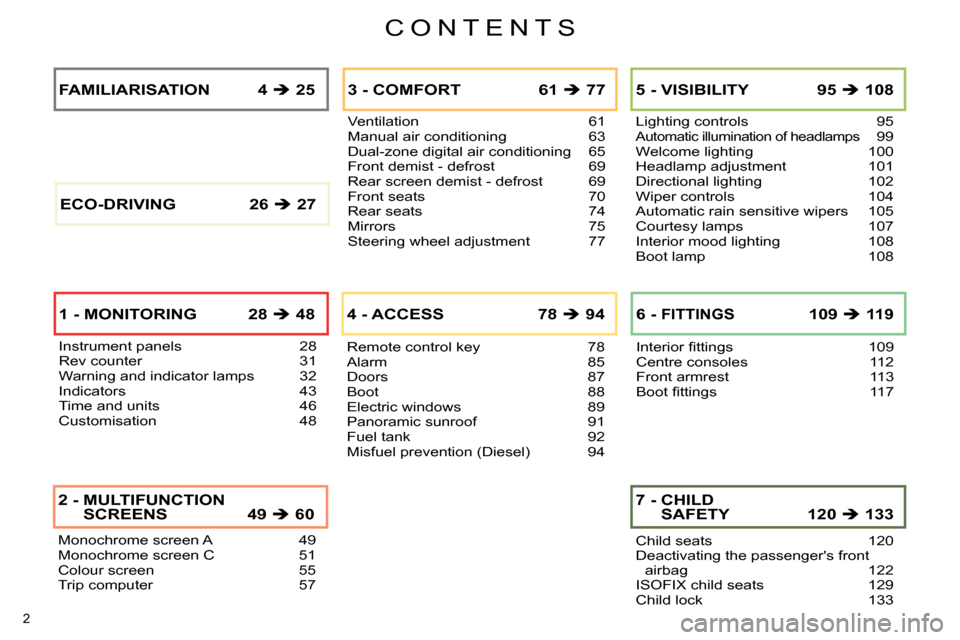
CONTENTS
2
Monochrome screen A 49
Monochrome screen C 51
Colour screen 55
Trip computer 57
2 - MULTIFUNCTION
SCREENS 49 60
Ventilation 61
Manual air conditioning 63
Dual-zone digital air conditioning 65
Front demist - defrost 69
Rear screen demist - defrost 69
Front seats 70
Rear seats 74
Mirrors 75
Steering wheel adjustment 77
3 - COMFORT 61 77
Remote control key 78
Alarm 85
Doors 87
Boot 88
Electric windows 89
Panoramic sunroof 91
Fuel tank 92
Misfuel prevention (Diesel) 94
4 - ACCESS 78 94
Lighting controls 95Automatic illumination of headlamps 99
Welcome lighting 100
Headlamp adjustment 101
Directional lighting 102
Wiper controls 104
Automatic rain sensitive wipers 105
Courtesy lamps 107
Interior mood lighting 108
Boot lamp 108
5 - VISIBILITY 95 108
Interior fi ttings 109
Centre consoles 112
Front armrest 113
Boot fi ttings 117
6 - FITTINGS 109 11 9
Instrument panels 28
Rev counter 31
Warning and indicator lamps 32
Indicators 43
Time and units 46
Customisation 48
FAMILIARISATION 4 25
1 - MONITORING 28 48
Child seats 120
Deactivating the passenger's front
airbag 122
ISOFIX child seats 129
Child lock 133
7 - CHILD
SAFETY 120 133 ECO-DRIVING 26 27
Page 5 of 328
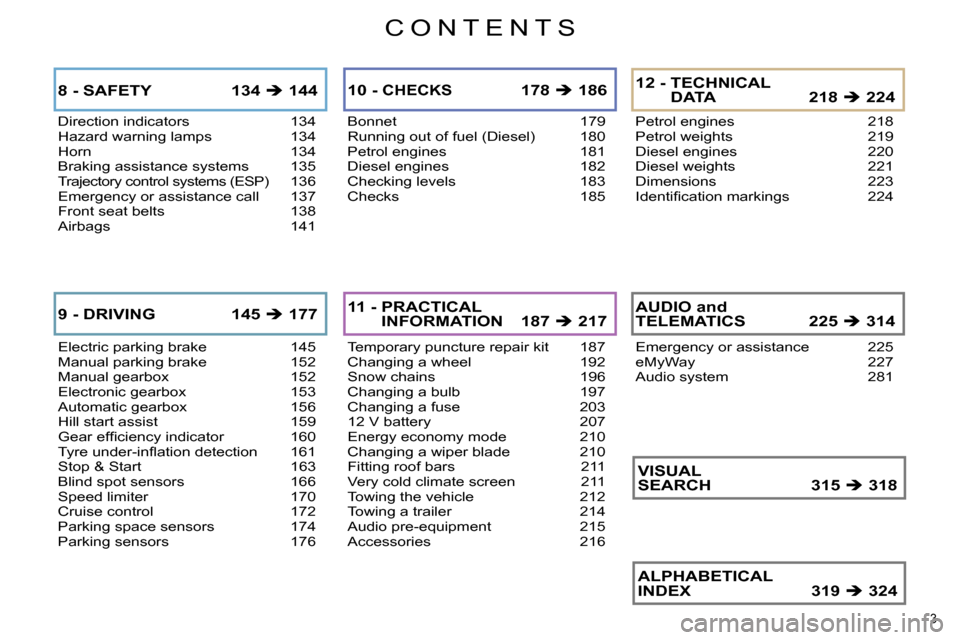
CONTENTS
3
Direction indicators 134
Hazard warning lamps 134
Horn 134
Braking assistance systems 135
Trajectory control systems (ESP) 136
Emergency or assistance call 137
Front seat belts 138
Airbags 141
8 - SAFETY 134 144
Electric parking brake 145
Manual parking brake 152
Manual gearbox 152
Electronic gearbox 153
Automatic gearbox 156
Hill start assist 159
Gear effi ciency indicator 160
Tyre under-infl ation detection 161
Stop & Start 163
Blind spot sensors 166
Speed limiter 170
Cruise control 172
Parking space sensors 174
Parking sensors 176
9 - DRIVING 145 177
Bonnet 179
Running out of fuel (Diesel) 180
Petrol engines 181
Diesel engines 182
Checking levels 183
Checks 185
10 - CHECKS 178 186
Temporary puncture repair kit 187
Changing a wheel 192
Snow chains 196
Changing a bulb 197
Changing a fuse 203
12 V battery 207
Energy economy mode 210
Changing a wiper blade 210
Fitting roof bars 211
Very cold climate screen 211
Towing the vehicle 212
Towing a trailer 214
Audio pre-equipment 215
Accessories 216
11 - PRACTICAL
INFORMATION 187 217
Petrol engines 218
Petrol weights 219
Diesel engines 220
Diesel weights 221
Dimensions 223
Identifi cation markings 224
12 - TECHNICAL
DATA 218 224
Emergency or assistance 225
eMyWay 227
Audio system 281
AUDIO and
TELEMATICS 225 314
ALPHABETICAL
INDEX 319 324 VISUAL
SEARCH 315 318
Page 6 of 328
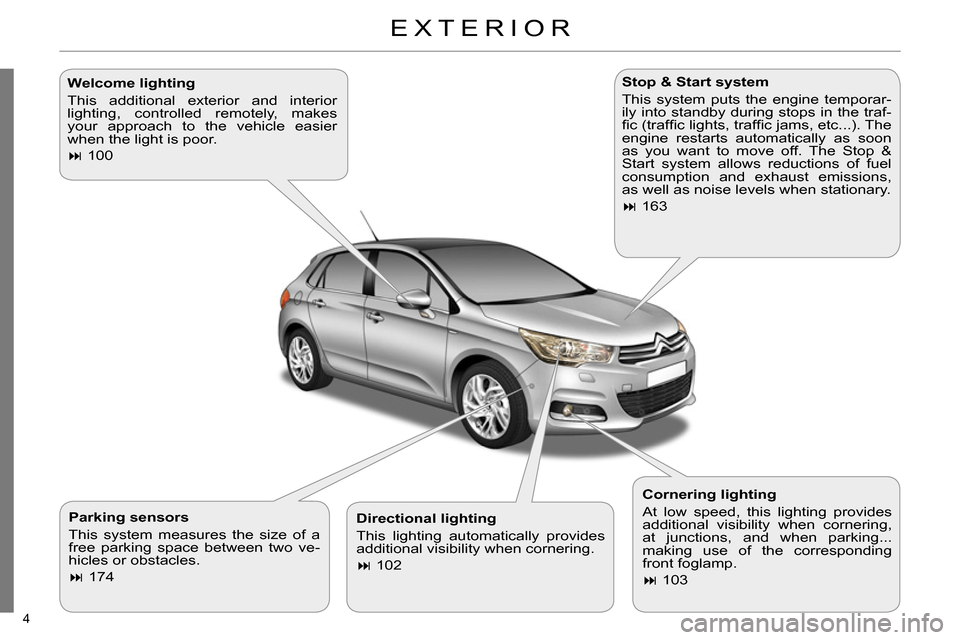
4
Parking sensors
This system measures the size of a
free parking space between two ve-
hicles or obstacles.
174
Stop & Start system
This system puts the engine temporar-
ily into standby during stops in the traf-
fi c (traffi c lights, traffi c jams, etc...). The
engine restarts automatically as soon
as you want to move off. The Stop &
Start system allows reductions of fuel
consumption and exhaust emissions,
as well as noise levels when stationary.
163
Welcome lighting
This additional exterior and interior
lighting, controlled remotely, makes
your approach to the vehicle easier
when the light is poor.
100
Directional lighting
This lighting automatically provides
additional visibility when cornering.
102
Cornering lighting
At low speed, this lighting provides
additional visibility when cornering,
at junctions, and when parking...
making use of the corresponding
front foglamp.
103
EXTERIOR
Page 9 of 328
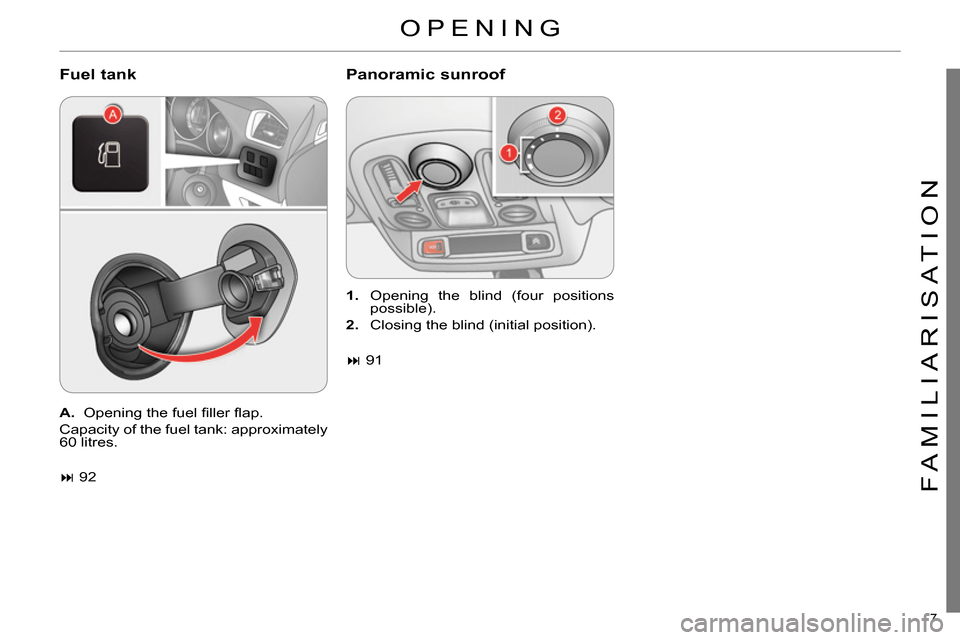
7
FAMILIARISATION
Fuel tank
Panoramic sunroof
92
1.
Opening the blind (four positions
possible).
2.
Closing the blind (initial position).
91
A.
Opening the fuel fi ller fl ap.
Capacity of the fuel tank: approximately
60 litres.
OPENING
Page 11 of 328

9
FAMILIARISATION
1.
Controls for audio and telematic
system.
2.
Controls for Bluetooth system or
telephone.
3.
Steering lock and ignition.
4.
Wiper / screenwash / trip computer
control stalk.
5.
Instrument panel.
6.
Driver's airbag.
Horn.
7.
Cruise control / speed limiter
switches.
8.
Controls for optional functions.
9.
Door mirror controls.
Electric window controls.
10.
Oddments storage.
11 .
Manual headlamp height
adjustment
Lower side switch panel.
12.
Fuel fi ller fl ap opening button.
Upper side switch panel.
13.
Side adjustable air vent.
14.
Front side window demisting vent.
INSTRUMENTS AND CONTROLS
Page 19 of 328

17
FAMILIARISATION
Instrument panels
Warning lamps
Central switch panels
A.
With the ignition on, the bars indi-
cate the level of fuel remaining.
B.
With the engine running, its associ-
ated low level warning lamp should
go off.
C.
With the ignition on, the oil level in-
dicator should show for a few sec-
onds that the level is OK or correct,
depending on version.
28
1.
With the ignition on, the orange and
red warning lamps come on.
2.
With the engine running, these
warning lamps should go off.
32
A.
Make an emergency call.
137, 225
B.
Access to CITROËN services.
137, 225
C.
Hazard warning.
134
D.
Central locking.
83
E.
Black panel (black screen).
47
If the levels are not correct, top up the
levels which are low. If warning lamps remain on, refer to the
relevant page.
MONITORING
Page 21 of 328

19
FAMILIARISATION
Passenger's front airbag
Seat belts and passenger's
front airbag
Ignition switch
1.
Open the glove box.
2.
Insert the key.
3.
Select the position:
"OFF"
(deactivation), with "rear fac-
ing" child seat,
"ON"
(activation), with front pas-
senger or "forwards facing" child
seat.
4.
Remove the key keeping the switch
in the new position.
142
A.
Front left seat belt not fastened / un-
fastened warning lamp.
B.
Front right seat belt not fastened /
unfastened warning lamp.
C.
Rear right seat belt unfastened
warning lamp.
D.
Rear centre seat belt unfastened
warning lamp.
E.
Rear left seat belt unfastened warn-
ing lamp.
F.
Passenger's front airbag deactivat-
ed warning lamp.
G.
Passenger's front airbag activated
warning lamp.
138, 142
1.
Stop
position.
2.
Ignition on
position.
3.
Starting
position.
80
When switching the ignition on or off,
the speedometer needle and the rev
counter and fuel gauge bars go full
travel and then return to 0.
PASSENGER SAFETY - STARTING
Page 25 of 328
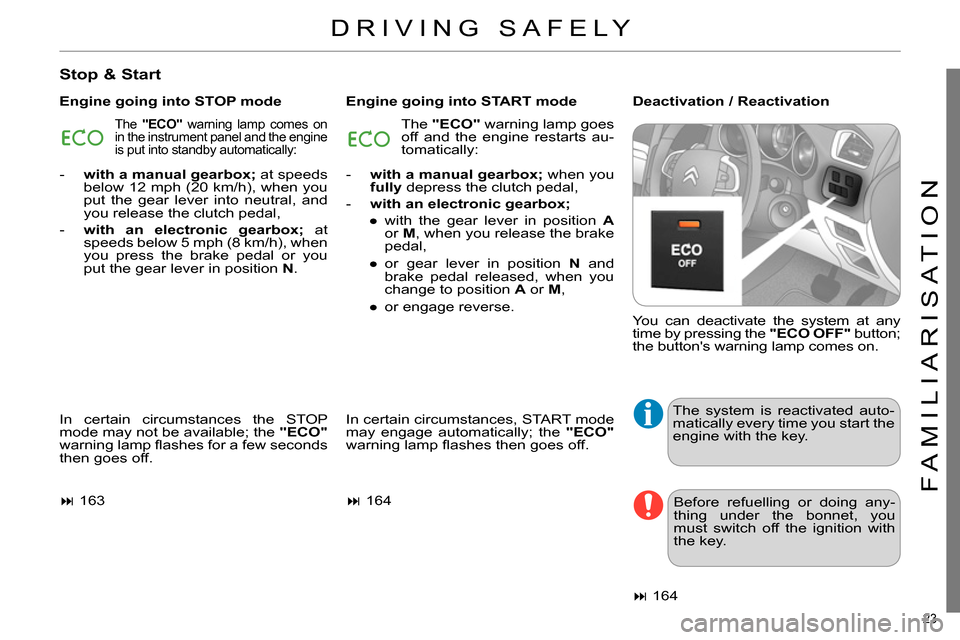
23
FAMILIARISATION
Stop & Start
Engine going into STOP mode
Engine going into START mode
Deactivation / Reactivation
In certain circumstances the STOP
mode may not be available; the "ECO"
warning lamp fl ashes for a few seconds
then goes off.
- with a manual gearbox;
at speeds
below 12 mph (20 km/h), when you
put the gear lever into neutral, and
you release the clutch pedal,
- with an electronic gearbox;
at
speeds below 5 mph (8 km/h), when
you press the brake pedal or you
put the gear lever in position N
.
163
- with a manual gearbox;
when you
fully
depress the clutch pedal,
- with an electronic gearbox;
●
with the gear lever in position A
or M
, when you release the brake
pedal,
●
or gear lever in position N
and
brake pedal released, when you
change to position A
or M
,
●
or engage reverse.
In certain circumstances, START mode
may engage automatically; the "ECO"
warning lamp fl ashes then goes off.
164
You can deactivate the system at any
time by pressing the "ECO OFF"
button;
the button's warning lamp comes on.
164
The "ECO"
warning lamp goes
off and the engine restarts au-
tomatically:
The "ECO"
warning lamp comes on
in the instrument panel and the engine
is put into standby automatically:
The system is reactivated auto-
matically every time you start the
engine with the key.
Before refuelling or doing any-
thing under the bonnet, you
must switch off the ignition with
the key.
DRIVING SAFELY
Page 28 of 328

26
Eco-driving is a range of everyday practices that allow the motorist to optimise their fuel consumption and CO2 emissions.
Optimise the use of your
gearbox
With a manual gearbox, move off gen-
tly and change up without waiting.
During acceleration change up early.
With an automatic or electronic gear-
box, give preference to automatic mode
and avoid pressing the accelerator
pedal heavily or suddenly.
Drive smoothly
Maintain a safe distance between ve-
hicles, use engine braking rather than
the brake pedal, and press the accel-
erator progressively. These practices
contribute towards a reduction in fuel
consumption and CO
2 emissions and
also helps reduce the background traf-
fi c noise.
If your vehicle has cruise control, make
use of the system at speeds above
25 mph (40 km/h) when the traffi c is
fl owing well.
Control the use of your
electrical equipment
Before moving off, if the passenger
compartment is too warm, ventilate it
by opening the windows and air vents
before using the air conditioning.
Above 30 mph (50 km/h), close the
windows and leave the air vents open.
Remember to make use of equipment
that can help keep the temperature
in the passenger compartment down
(sunroof and window blinds...).
Switch off the air conditioning, unless
it has automatic regulation, as soon as
the desired temperature is attained.
Switch off the demisting and defrosting
controls, if not automatic.
Switch off the heated seat as soon as
possible.
The gear effi ciency indicator invites
you to change up: as soon as the in-
dication to change up is displayed in
the instrument panel, follow it straight
away.
With an electronic or automatic gear-
box, this indicator appears only in
manual mode.
ECO-DRIVING
Page 29 of 328

27
Switch off the headlamps and front
foglamps when the level of light does
not require their use.
Avoid running the engine before moving
off, particularly in winter; your vehicle
will warm up much faster while driving.
As a passenger, if you avoid connecting
your multimedia devices (fi lm, music,
video game...), you will contribute to-
wards limiting the consumption of elec-
trical energy, and so of fuel.
Disconnect your portable devices be-
fore leaving the vehicle.
Limit the causes of excess
consumption
Spread loads throughout the vehicle;
place the heaviest items in the bottom
of the boot, as close as possible to the
rear seats.
Limit the loads carried in the vehicle
and reduce wind resistance (roof bars,
roof rack, bicycle carrier, trailer...). Use
a roof box in preference.
Remove roof bars and roof racks after
use.
At the end of winter, remove snow
tyres and refi t your summer tyres.
Observe the recommendations
on maintenance
Check the tyre pressures regularly,
when cold, referring to the label in the
door aperture, driver's side.
Carry out this check in particular:
- before a long journey,
- at each change of season,
- after a long period out of use.
Don't forget the spare wheel and the
tyres on any trailer or caravan.
Have your vehicle serviced regularly
(engine oil, oil fi lter, air fi lter...) and ob-
serve the schedule of operations rec-
ommended by the manufacturer.
When refuelling, do not continue after
the third cut-off of the nozzle to avoid
any overfl ow.
At the wheel of your new vehicle, it is only
after the fi rst 1 800 miles (3 000 kilometres)
that you will see the fuel consumption set-
tle down to a consistent average.